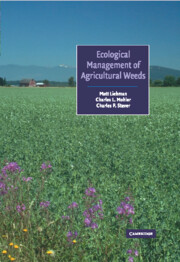Book contents
- Frontmatter
- Contents
- Preface
- 1 Weed management: a need for ecological approaches
- 2 Weed life history: identifying vulnerabilities
- 3 Knowledge, science, and practice in ecological weed management: farmer–extensionist–scientist interactions
- 4 Mechanical management of weeds
- 5 Weeds and the soil environment
- 6 Enhancing the competitive ability of crops
- 7 Crop diversification for weed management
- 8 Managing weeds with insects and pathogens
- 9 Livestock grazing for weed management
- 10 Weed evolution and community structure
- 11 Weed management: the broader context
- Taxonomic index
- Subject index
6 - Enhancing the competitive ability of crops
Published online by Cambridge University Press: 10 November 2009
- Frontmatter
- Contents
- Preface
- 1 Weed management: a need for ecological approaches
- 2 Weed life history: identifying vulnerabilities
- 3 Knowledge, science, and practice in ecological weed management: farmer–extensionist–scientist interactions
- 4 Mechanical management of weeds
- 5 Weeds and the soil environment
- 6 Enhancing the competitive ability of crops
- 7 Crop diversification for weed management
- 8 Managing weeds with insects and pathogens
- 9 Livestock grazing for weed management
- 10 Weed evolution and community structure
- 11 Weed management: the broader context
- Taxonomic index
- Subject index
Summary
Introduction
Many cultural practices, including crop density, arrangement, planting date and choice of cultivar affect the crop's ability to compete with weeds. However, most recommendations for the planting of crops are based on the assumption that weeds are absent. This is a result of the scientific and economic context in which recommendations are developed. Variety trials, fertility rate trials, and many other agronomic experiments are usually run in weed-free conditions to avoid the confounding effect of weed competition. For the agronomist or horticultural scientist, keeping a particular experiment free of weeds is a practical possibility. Given the high spatial and temporal variability in density and composition of weed communities, a weed-free trial may also be the easiest way to generate results that are applicable over a wide area. In addition, weeds generally decrease yield regardless of other parameters. Consequently, weeds are usually excluded from experiments unless they are specifically the object of investigation. However, weed-free fields are rarely practical on the farm, and as explained in the following sections, the presence of weeds generally changes the optimal choices for cultural practices relative to those developed in weed-free conditions.
The central thesis of this chapter is that the density, arrangement, cultivar, and planting date of the crop that maximize the rate at which the crop occupies space early in the growing season usually minimize competitive pressure of weeds on the crop.
- Type
- Chapter
- Information
- Ecological Management of Agricultural Weeds , pp. 269 - 321Publisher: Cambridge University PressPrint publication year: 2001
- 73
- Cited by



